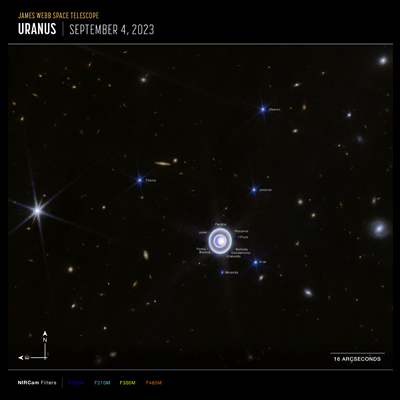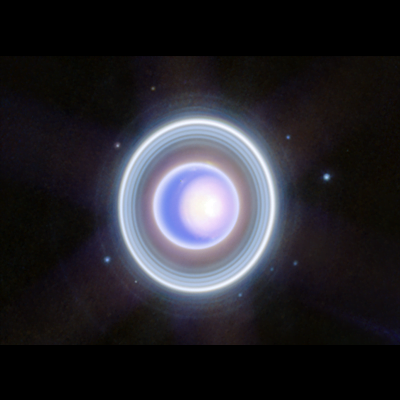Introduction
In a groundbreaking celestial endeavor, NASA’s James Webb Space Telescope recently turned its lenses toward the enigmatic Uranus, an ice giant that defies conventional planetary norms. This captivating event unfolded as Webb captured the dynamic world adorned with rings, moons, storms, and intriguing atmospheric features, including a seasonal polar cap. This article delves into the revelations brought forth by Webb’s meticulous observations, shedding light on the mysteries of Uranus.

Unveiling Uranus: A Visual Symphony
The Ice Giant in Technicolor
In visible wavelengths, as witnessed by Voyager 2 in the 1980s, Uranus presented itself as a serene, solid blue ball. However, Webb’s infrared lens paints a different picture, revealing a vibrant and dynamic ice world teeming with atmospheric marvels.
Rings and Moons Dance
Webb’s unparalleled sensitivity captured not only Uranus’s inner and outer rings but also revealed the elusive Zeta ring – an extremely faint and diffuse ring huddled closest to the planet. The telescope’s lens didn’t stop there; it ventured into the realm of Uranus’s 27 known moons, even capturing some smaller moons nestled within the intricate dance of rings.
Uranus’s Seasonal North Polar Cloud Cap
A Closer Look at the Cap
Of the many captivating features observed, Webb zoomed in on Uranus’s seasonal north polar cloud cap. Comparing images from earlier this year, nuances in the cap become more apparent, including the bright, white, inner cap and a dark lane at the cap’s bottom, towards lower latitudes.
Storms on the Horizon
Webb’s lens didn’t miss the action below the polar cap, spotting several bright storms. The frequency and location of these storms might be influenced by a combination of seasonal and meteorological effects. As Uranus approaches its next solstice in 2028, astronomers are keenly anticipating any structural changes in these stormy features.
Uranus’s Eccentric Tilt: Seasons Like No Other
A Planet on Its Side
Uranus’s unique tilt, approximately 98 degrees, sets the stage for the most extreme seasons in the solar system. For a significant portion of each Uranian year, one pole basks in sunlight, while the other half plunges into a dark, 21-year-long winter. Webb’s infrared prowess unravels the complexities of Uranus’s seasonal variations with unprecedented clarity.
A Glimpse into the Future: 2028 Solstice
With Uranus gearing up for its next solstice in 2028, astronomers anticipate changes in the planet’s atmospheric dynamics. Webb’s role in disentangling the intricate dance between seasonal and meteorological effects becomes crucial in deciphering Uranus’s atmospheric mysteries.
Uranus as a Cosmic Proxy: Insights for Exoplanetary Studies
Beyond Our Solar System
Uranus, with its peculiarities and idiosyncrasies, serves as a cosmic proxy for understanding the plethora of similarly sized exoplanets discovered in recent decades. As Webb captures intricate details, especially of the elusive Zeta ring, scientists gain invaluable insights that can inform future missions to Uranus and enhance our comprehension of exoplanetary systems.
A Key to Exoplanetary Understanding
The study of Uranus’s meteorology, structure, and formation provides a blueprint for decoding the workings of nearly 2,000 comparable exoplanets. This “exoplanet in our backyard” contributes to the broader understanding of planetary systems and aids in contextualizing our own solar system within the vast cosmic landscape.
Conclusion
In the vastness of our solar system, Uranus emerges as a celestial enigma, and the lens of NASA’s James Webb Space Telescope is unraveling its mysteries with unprecedented clarity. As we await the approaching solstice in 2028, Webb’s observations promise to deepen our understanding of Uranus’s complex atmosphere, storms, and unique features. Furthermore, Uranus stands as a cosmic mirror, reflecting insights that extend beyond our solar system, offering a key to unlocking the secrets of exoplanetary realms.
Read More
Brawlhalla and SpongeBob SquarePants: An Unprecedented Crossover Event
Breaking News: Satellite Catastrophe Looming – Are We Ready for the Fallout?
Level Up Your Gaming Experience with Sifu Update 1.26: Uncover the Thrilling Enhancements!
Time Travel: Quantum Physics Breakthrough Revealed!
Unleash Chaos in Mortal Kombat 1 with Omni-Man! Must-See Trailer & Gameplay Revealed!
Exploring the Wonders of Space: A Year-Long Journey
The Diversity of Human Origins: A Glimpse from Africa
The Black Mage of Final Fantasy 14 – A Finger-Lickin’ Crossover
Transform Your Home into a Smart Haven
The Tasmanian Tiger: A Remarkable Scientific Endeavor
John D. “Danny” Olivas: A Remarkable Journey from El Paso to Space
A Guide to Pre-Ordering Apple Products in the United States
Google’s Threat Analysis Group: North Korean State Hackers Target Security Researchers
Why is Uranus tilted on its side?
Uranus’s extreme tilt is thought to be the result of a colossal collision early in its formation, setting it on a unique rotational path.
How does Webb’s infrared resolution enhance our view of Uranus?
Webb’s infrared capabilities reveal details not visible in visible light, providing a clearer picture of Uranus’s atmospheric dynamics, rings, and moons.
What is the significance of studying Uranus in the context of exoplanets?
Uranus, as a celestial neighbor, offers a valuable reference point for understanding the diverse exoplanetary systems discovered beyond our solar system.
How often do storms appear in Uranus’s atmosphere?
The frequency and location of storms on Uranus appear to be influenced by a combination of seasonal and meteorological effects.
How does Webb’s observation of Uranus contribute to future space missions?
Webb’s detailed observations, including the Zeta ring and atmospheric features, provide crucial information for planning and executing future missions to Uranus.


